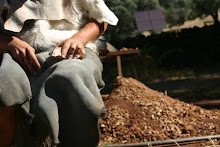Aqui ficam os nossos resumos:
Sesión: Arqueología Experimental aplicada a la didáctica y el Patrimonio
Histórico/Experimental Archaeology, Didactic and Historical Heritage
Andakatu Project: Prehistory didactics and experimentation
Sara Cura, Pedro Cura e Luiz Oosterbeek
Sara Cura, Pedro Cura e Luiz Oosterbeek
The didactic programme of the Prehistoric art Museum of Mação is largely embodied of the conviction that knowledge is acquired through practical activities. Experimentation is the most efficient mode to establish a more tangible bridge between the present and the ways of living of prehistoric communities. Although being a small part of the official educational programmes, for many Portuguese children and adults prehistory is still attached to objects in museums’ exhibitions. These are too often deprived of dynamism, functional and social context.
In cooperation with the scientific research, namely the experimental studies developed in the research centre of Mação (ITM), the didactic activities try to develop the perception of the museum artefacts throughout the empirical understanding of its technological production and utilization.
To better achieve these goals, the Museum developed a unique didactic project in Portugal, where a character named Andakatu leads children, youngsters and adults into the path of human evolution. Through archaeological experimentation and involving the participants in learning by doing process, the project has been successfully engaging in archaeology and prehistory thousands of children in Portugal and abroad (United Kingdom, Brazil and Spain).
The activities with Andakatu lead children into several kinds of experimentations, for example:
· technological (knapping and polish of stones, clay preparation for vessels manufacture and firing),
· artistic (painting with mineral and organic pigments, carving with stone tools)
· and food preparation (using different kinds of hearths, ingredients and techniques).
Key words: didactic, prehistory, experimentation
Sesión: Arqueología Experimental y Traceología / Experimental Archaeology and
Traceology (27 noviembre/november)
Usewear traces or retouch?
Experiments to understand a Middle Pleistocene human behaviour in central Portugal.
Stefano Grimaldi, Emanuela Cristiani, Sara Cura e Luiz Oosterbeek
Experiments to understand a Middle Pleistocene human behaviour in central Portugal.
Stefano Grimaldi, Emanuela Cristiani, Sara Cura e Luiz Oosterbeek
A first impression one may receive while overviewing the lithic assemblages of the middle Tagus valley (central Portugal) is their apparent - almost monotonous – homogeneity. Alleged similarities among artefacts associated to anthropogenic occupations stratigraphically attributed to very different chronological contexts (from middle Pleistocene to the late Holocene), required an in-depth study aiming at disentangling this similarities.
This lead to the launching of a 9 years project (1998-2007) named TEMPOAR (Territory, Mobility and Settlement), coordinated by the Instituto Politecnico de Tomar (Portugal), which aimed the establishment of a chronological and a techno-typological characterization of these lithic assemblages as well as an extended comprehension of the archaeological sites in relation with the Quaternary deposits of Middle Tagus and its tributaries. To achieve its goals, the TEMPOAR project set out the study of the surface lithic collections, the excavation of both Palaeolithic and Holocene sites and the production of thematic maps (elaborated with Geographical Information System) in order to provide a more rigorous articulation of archaeological sites and their respective geological deposits.
It’s within this framework that the Middle Pleistocene open air site of Ribeira Ponte da Pedra (RPP, also known as Ribeira da Atalaia) has been excavated since 1999. The site is the only middle Pleistocene site still under excavation in Portugal; former Pleistocene excavations were those at Fonte da Moita (Vila Nova da Barquinha, central Portugal), stratigraphically dated to the same age of RPP site, and Santa Cita (near Tomar, central Portugal) dated to at about 50 kyrs.
The lithic industry found in the Middle Pleistocene layers at RPP site is essentially characterized by three major groups: worked pebbles, non retouched blanks, and «retouched like» blanks; all of them have been knapped from quartzite pebbles, the only raw material available in the region.
“Retouched-like” blanks are mainly cortical or half cortical. Their percentage decreases along with the decrease of cortex presence, being quite rare among non cortical flakes. This seems to suggest that blanks showing modified edges were mainly needed in the cortical blanks category. However, the so far analysed implements present a quite marginal, coarse and atypical retouch, quite variable in its position and localisation and not resulting on «classic types» of formal tools.
A possible explanation for this behaviour could be due to blanks produced mostly to obtain functional edges to cut or scrape, but without the need of being retouched.
In this work, Authors will present the results of experimental and functional studies confirming that most of the edges showing an “atypical” retouch can be attributed to different types of edge-modifications resulting from subsistence activities, mainly corresponding to wood work.
Experiments also demonstrated the high degree of efficiency of quartzite blanks when they are being used for several subsistence activities such as chopping small trees, cutting or scraping bone and wood, butchering medium-small size animals.

